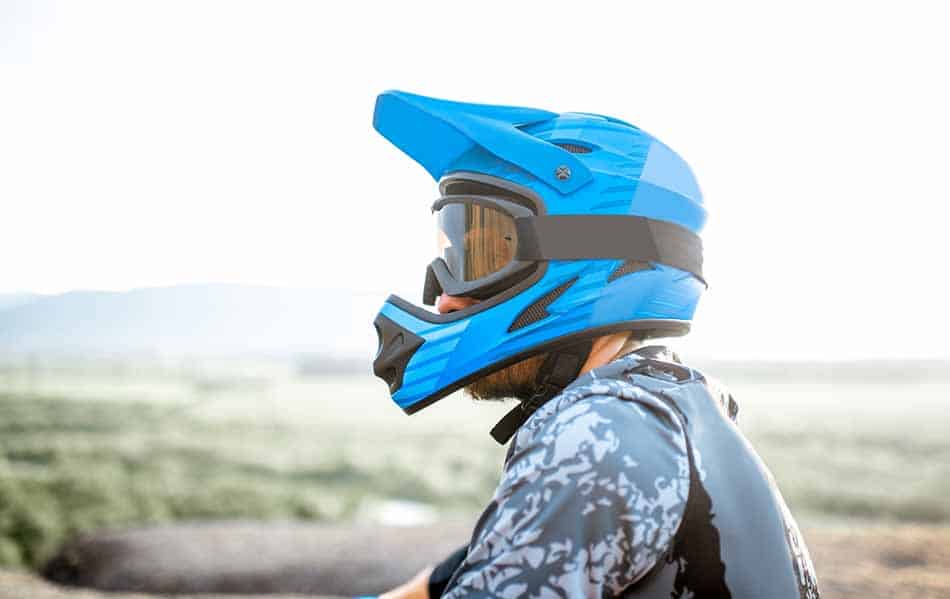
You do not have to delve too far into the cycling community before you come across the debate regarding the benefits of wearing a helmet for your bike commute. There are arguments on both sides which can definitely become fanatical about the benefits and detriments are wearing a helmet for your bike commute and whether or not they actually improve your safety.
For bike commuting, a full face bicycle helmet is not required by law and you may not want to got that way due to discomfort, heat and reduced visibility. The key to determining the best helmet will depend on your bike commuting route and terrain.
Whilst helmet safety benefits are under constant debate, I wouldn’t consider commuting without one. Depending on your route, roads can be very busy and accidents can happen. I would personally like to put a little protection between me and the hard surfaces my head could come into contact with, but there is a balance here. For example, I don’t choose to wear any other pad protection on my body due to the downsides, but I feel my head is a more important instrument to protect and it gives me peace of mind when out on my morning commute.
Even at low speed collisions and accidents, the risk of serious injury is significantly higher without a helmet. Modern designs are stylish and comfortable so there really is no excuse not to wear one. Your life may literally depend on it.
A study from 2016 collected data from over 64,000 cyclists around the world and found compelling evidence that wearing a cycle helmet reduces the risk of serious head injury by almost 70% and fatal head injury by 65%. It is the largest review on cycling and helmets to date. The study also found that the risk of sustaining a general head injury is reduced by 51% and facial injury by 33% when a helmet is used (Olivier, Creighton, 2016).
Cycle helmets should always be fitted and worn correctly, be free of any damage, and marked with the safety standard EN1078 (for adults) or EN1080 (for children).
You can view our recommended helmets here.
So why would we not recommend a full face helmet. Surely, the more protection you can get the better, right?? Obviously, helmet choice is personal preference, and if you are more confident on the road with a full face helmet, then that would be the route to go do. Being bike confident, especially when road riding in traffic, is important to help keep you safe, along with other measure which we reccomend here.
The problem with full face helmets is that they also come with downsides and these need to be assessed before deciding if they are the right option for you. Here we look at the benefits and detriments in more detail.
Benefits of Full Face Helmets for Bike Commuting
Full Face Protection
Ok, this one is obvious but it is worth exploring. Having a full face helmet will protect your face from impact with hard surfaces. You will get a higher level of protection from an open helmet and reduced injury from your chin or face coming into contact with the ground during an accident. This is worth considering, especially if your terrain on your commute is uneven and you have an aggressive riding style.
Acts as a Face and Mouth Cover
With a full face helmet, you are likely to swallow less flies on your commute and it will double up as a face covering, helping to protect you from wind, rain, flying stones and other debris. It will also help to deflect pollution to a certain degree, although this should not be relied upon as the only protection.
Not being a full face rider, I do have to wear protective glasses at all times to protect from stones and other debris from being flung into my eyes. They also stop the wind from making my eye constantly water so are an important accessory. In the winter, when raining, it is a problem to keep them clean and clear and a full face helmet may just do the trick, meaning I could retire the glasses.
I also wear protecting face coverings to keep warm in winter. These are in the form of scarves or balaclavas which would not be needed in some situation should I opt for a full face helmet to keep out the weather. Under garments would probably still be needed in the coldest weather but these may be rare occurrences, depending on the climate your commute takes place in.
Protect Your Identity
This is probably not that important to most people, unless you are a spy or secret agent. Most likely, you are not. However, some bike commuters do have a lack of confidence and feel a bit silly riding their bike to work. a full face helmet may be enough to park these insecurities and get you moving. This may be the only motivation you need and the only thing that was stopping you taking to the saddle on your commute. So go for it!!
Detriments of Full Face Helmets for Bike Commuting
Increase Temperature
With the added protection comes a number of downsides, one of which is the increased temperature you will feel in the helmet. The airflow is restricted and so you will get hotter and not remove as much heat from your face and head. Modern helmets are designed to promote ventilation but nevertheless, you will be hotter in this type of full face helmet. This may not be an issue in colder climates, it may in fact be beneficial, but when bike commuting in the summer months this is likely to be less comfortable.
With increased temperature, comes more sweat. You will sweat more in a full face helmet. It is inevitable. I sweated so much in a full face that it started to go in my eyes and effect my vision. This isn’t a problem with an open helmet design. The airflow due to the speed of the bike does a great job of removing heat from the face and avoiding this problem with an open helmet design.
Reduced Visibility
The nature of the full face helmet is to cover more of your face. This will reduce your field of vision and peripheral vision. Obviously on a busy commute, you need to have you wits about you and spot potential dangers and obstacles before they become an accident. This reduce visibility could mean you miss the driver in your blind spot, or the pedestrian stepping out. Never a good idea.
Being vigilant about your personal safety while bike commuting is paramount and something we take seriously. We have some tips on keeping you safe on your bike commute here. Our opinion, is the tradeoff with the increase protection a full face helmet gives, verses the reduced visibility is not a good one. Spacial awareness and observation will be much more important in normal urban riding settings.
You Look Less Human
Ok, this one is a little abstract and you can argue whether there is any actual facts around it but there is a certain logic to it. If driver can’t see your face, do they act differently towards you? Who knows. This could be a factor. I do find that driver eye contact is a good way to maintain a safe ride, especially when riding in traffic. Before making a turn always make sure the driver has looked me in the eye to give me confidence that they have seen me. A little trick that makes me a more confident rider.
This could be undermined with a full face helmet. Personally, I don’t like the idea of drivers thinking I am more protected than I am when I am bike commuting. I like them to see me, be able to communicate with me (non-verbally) and see me as another road user who is much more vulnerable than then when on my bike. The small amount of additional protection afforded by a full face helmet, is not sufficient when compared to the downsides.
Choosing A Full Face Helmet Or Not
I am a road cyclist and use busy, city centre and suburb roads when on my commute and so my opinion of this subject is biased towards that type of cycling. In urban cycling situations, visibility and communication are key factors in your safety as a cyclist and for these reasons I opt for a standard road cycling, open helmet. The downsides of a full face helmet do not outweigh the added protection it may provide.
However, there are certain situation when this may not be the case, and a number of factors play into the decision. These are discussed below to try to help you make an informed decision.
What Type Of Cycling Do You Do?

If, like me you are a keen road cyclings, weaving and dodging traffic, parked cars and other hazards, it is important to maintain a good level of visibility, as already discussed in this article. On the other hand, if you are cycling off-road as part of your commute, with a challenging terrain, you may opt for an alternative solution.
The risk of falling off a road bike is fairly low due to cycling error alone, the paths and roads are smooth with very little danger. A little debris can cause issues, especially when travelling at speed on a road bike but these can usually be avoided. I have cycled multiple 100 mile sportive and never actually fallen off my bike due to my error alone. The chances, vastly increase due to all the other hazards we find on our roads. Pedestrians, other road users, road maintenance works and other hazards are what make the road cycle more dangerous than it need be. The key to avoiding and managing these hazards are to have good levels of visibility to prevent them becoming an issue, rather than a helmet that will protect you if you do have an issue.
If you ride off road alternatively, the chances are an accident are increased, despite other factors. Rough terrain is difficult to predict and hence can lead to more accidents when compared to road commutes, all other factor being equal. In this situation, you may be more tempted to protect yourself from the fall rather than trying to mitigate the risk in the first place. Chances are you are less likely to solve the problems of an off road commute by increasing visibility and hence, protecting your self may be worthy of further consideration.
Conclusion
You can probably tell from the article that we are not sold on using a full face helmet for your commute. In most cases, commuting is a mixture of roads and cycle paths and you can’t avoid traffic in most commutes. For this reason, the increased visibility offered with an open helmet design has many advantages over a full face helmet when safety is concerned, especially when considering the increased visibility.
This choice is always going to divide opinion though, and the key thing is to ensure that you are confident on your bike and ride safely. if a full face helmet means you feel safer, you will generally ride safer and so you should not compromise on that. Just be mindful of the safety trade offs you may be making before you finalise your selection.
Happy commuting!!!

